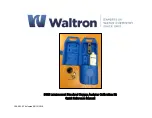
IM 12B06J07-02E-E
15
Calibration of the SC24V sensor has to be done
with the pH analyzer connected. Normally the
pH standards that are preprogrammed in the
pH analyzer can be used for calibration with the
pH analyzer set to
“AUTOCAL”
. The SC24V
however is a differential pH sensor which needs
pH buffers that have the same ionic strength
because the sodium reference will change as
the ionic strength changes. These pH buffers
are not preprogrammed in the pH analyzer,
which means the calibration has to be done
with specific buffer solutions (see Section
6.1) and the pH analyzer set to
“MANUAL”
calibration. Refer to the analyzer Instruction
Manual for details. Calibration data of the
sensor is stored into the pH analyzer.
6.1 Buffer calibration
To calibrate the SC24V sensor, two buffer
solutions with known pH values are required.
It is recommended that one buffer solution has
a value near to pH 7.00. Depending on the
process value to be measured, the second
buffer solution should be either acidic
(below pH 7.00) or alkaline (above pH 7.00).
Buffers which are available are: pH 4.00,
pH 7.00 and pH 9.00.
See Section 8 for ordering information.
The following is a very general 2-point manual
calibration procedure with buffer solution:
1. Clean the sensor using a 5% solution of HCl;
2. Rinse sensor thoroughly with tap water
(
DO NOT
use demineralized water);
3. Immerse the sensor in the first buffer solution
(pH 7.00 is recommended);
Set the pH analyzer to
“MANUAL”
calibration. Wait until the pH reading is stable.
Adjust the pH reading in the pH analyzer
to the value indicated on the bottle (in this
case 7.00). Go to solution 2 to do a 2-point
calibration;
4. Rinse sensor thoroughly with tap water;
5. Immerse the sensor in the second buffer
(pH 4.00 is recommended);
Wait until the pH reading is stable. Adjust the
pH reading in the pH analyzer to the value
indicated on the bottle (in this case 4.00).
Quit the manual calibration routine by
accepting the new calculated calibration data
of zero and slope.
After calibration, re-install the sensor into the
process.
Note:
It is important to understand it is possible
the SC24V differential sensor does
not show the correct pH value after
buffer calibration. The reason is that the
ionic strength of the buffers is 1 mol
NaCl, which can deviate from the ionic
strength of the process. For an accurate
pH reading an extra 1 point process
calibration has to be done (see Section
6.2) to compensate for differences in
ionic strength.
6.2 Process calibration
The following is a specific 1-point manual
calibration procedure for the process to
measure:
Set the pH analyzer to “
MANUAL
” calibration.
Wait until the pH reading is stable.
Adjust the pH reading in the pH analyzer to the
value of the process sample that is analyzed
using a laboratory measurement. For the
laboratory measurement, we advice to use the
Yokogawa PH72 personal pH meter.
Quit the manual calibration routine by accepting
the new calculated calibration data of zero.
Slope value will be unchanged.
6 GENERAL CALIBRATION & MAINTENANCE PROCEDURE
IM12B06J07-02E-E_ed05.indd 15
14/01/16 09:47






































